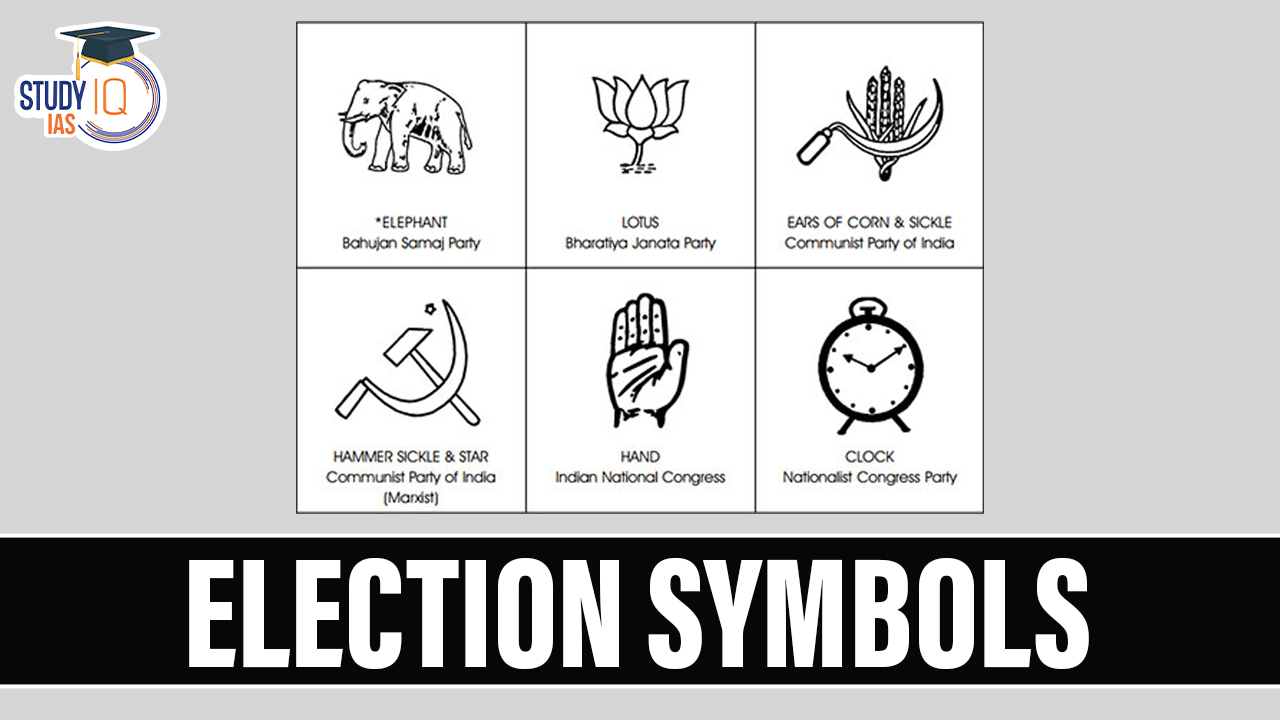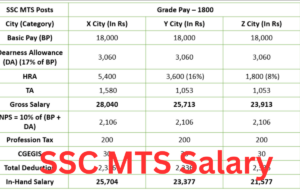Table of Contents
Context: The Election Commission of India refused to allocate the ‘Top’ symbol to the MDMK party in the current Lok Sabha elections.
The Naam Tamilar Katchi has been allotted a new common symbol and the Viduthalai Chiruthaigal Katchi has been denied a common symbol, raising questions on the allotment of symbols to registered unrecognised political parties (RUPPs).
The Madras High Court ruled that the Election Commission cannot be compelled to allocate the Top symbol to the MDMK Party, which has not contested in at least two parliamentary constituencies.
About Election Symbols
An electoral symbol is a specific mark assigned to a political party to help voters identify it easily. These symbols are used during campaigns and displayed on Electronic Voting Machines (EVMs) so that even illiterate voters can vote by recognizing the symbol instead of reading party names. In the 1960s, it was suggested that a law should manage the allocation of these symbols, leading to the Election Symbols (Reservation and Allotment) Order of 1968. The Election Commission (EC) oversees the registration of political parties and recognizes them as national or state parties based on their election performance. Recognized parties enjoy benefits like exclusive symbols, media time for broadcasts, and access to voter lists.
Under this order, the EC resolves disputes over party symbols, and its decisions have been upheld by the Supreme Court. For disputes in unrecognized parties, the EC advises factions to settle matters internally or go to court. Generally, a majority of party members tend to support one faction during these disputes. Before 1968, the EC used notifications and orders to manage symbols, and splinter groups had to register separately to claim their own status based on election performance.
Allocation of Election Symbols
- The Election Symbols (Reservation and Allotment) Order, of 1968 empowers the ECI to allot symbols to political parties.
- The ECI can decide on disputes among factions/groups/sections of a recognized political party staking a claim to its name and/or symbol, as per the above-mentioned order.
- The ECI is the only authority to decide on such disputes. The Supreme Court upheld this in the Sadiq Ali Vs ECI case, in 1971.
Symbols of Political Parties in Maharashtra
Maharashtra, a vibrant state in India with a rich political landscape, is home to various political parties. Each party is represented by a unique symbol that identifies it on the ballot and resonates with its ideology and voter base. Here’s a detailed look at the major political parties in Maharashtra and their symbols:
| Political Party | Symbol | Significance |
|---|---|---|
| Bharatiya Janata Party (BJP) | Lotus | Symbolizes purity and the ability to rise above adversities, reflecting development. |
| Indian National Congress (INC) | Hand | Represents trust, unity, and the upliftment of all sections of society. |
| Nationalist Congress Party (NCP) | Clock | Indicates urgency in addressing people’s needs and signifies progress. |
| Shiv Sena (UBT) | Flaming Torch (Mashaal) | Represents resilience and commitment to regional and nationalist ideologies. |
| Balasahebanchi Shiv Sena | Two Swords and a Shield | Reflects the legacy of Shivaji Maharaj, emphasizing pride and valor. |
| Maharashtra Navnirman Sena (MNS) | Railway Engine | Symbolizes speed, progress, and reform, particularly for the urban middle class. |
| Republican Party of India (RPI) | Elephant | Represents strength, patience, and empowerment of marginalized communities. |
| Samajwadi Party (SP) | Bicycle | Signifies simplicity and the empowerment of rural and underprivileged people. |
| Bahujan Samaj Party (BSP) | Elephant | Symbolizes social justice and the upliftment of Dalits and other backward communities. |
| Aam Aadmi Party (AAP) | Broom | Represents commitment to eradicating corruption and ensuring clean governance. |
Types of Election Symbols
Reserved Symbols
- These are reserved for recognized national and state political parties.
- Recognized National parties can use their exclusive and reserved symbol across the country.
- A recognized state party can use its exclusive and reserved symbol in a state in which it is recognized as such.
Free Symbols
The ECI has a pool of 193 ‘free’ symbols (as of June 2023) that are allotted to unrecognised parties and independent candidates.
Election Symbols of Political Parties with Names in India
In India, election symbols play an important role in the electoral process. The use of symbols helps illiterate voters recognize the party or candidate they want to vote for. Here are some common Election Symbols of Political Parties with Names used in India:
| Election Symbols of Political Parties: |
|
These symbols are allotted by the Election Commission of India to parties based on certain criteria and are aimed at aiding voters, particularly those who may be illiterate, in identifying the party or candidate they wish to vote for on the ballot paper.
Current Issue Related to Election Symbols
- Naam Tamilar Katchi (NTK): In 2019 and 2021, NTK secured 3.9% and 6.5% of votes in Tamil Nadu, respectively. It has been allocated the common symbol “Mike” for the upcoming elections, changing from its previous symbol “Ganna Kisan” due to a first-come-first-served rule.
- Viduthalai Chiruthaigal Katchi (VCK): VCK, which secured 1.09% and 0.99% votes in 2019 and 2021, respectively, has been denied the “Pot” symbol for failing to meet the 1% vote requirement in the 2021 State Legislative Assembly elections, despite having elected representatives.
Case of Political Party Split
- If a recognised political party splits, the Election Commission decides which faction can use the symbol.
- The Commission may also choose to freeze the symbol and ask both factions to contest in fresh symbols.
- For splits in registered but unrecognised parties, the ECI usually advises the warring factions to resolve their differences internally or to approach the court.
Criteria for Becoming a State Party
- Secure at least 6% of the valid votes polled in Assembly elections.
- Win two seats in Assembly polls or one seat in Lok Sabha polls.
OR
- Win 3% of seats in the legislative assembly of the State (minimum of 3 seats).
- Win 1 Lok Sabha seat for every 25 Lok Sabha seats allotted for the State.
- Poll 8% of votes in a State (either Lok Sabha or Legislative Assembly election).
Criteria for Becoming a National Party
- Be recognized as a State party in at least four States.
- Secure 6% of the total votes polled in four States (Lok Sabha or Assembly elections) and win four Lok Sabha seats.
- Win 2% of seats in the Lok Sabha from at least three different States.
Privileges of a Recognized Political Party
- Reserved party symbol: Ensures easy identification for voters during elections.
- Free broadcast time: Grants access to state-run media for campaigning.
- Consultation in election scheduling: Offers influence on election dates.
- Input on electoral rules: Allows participation in shaping election regulations.
| Facts |
|
Registered Unrecognized Political Parties (RUPPs)
- Definition: RUPPs are political parties that fall into one of two categories:
- Newly registered parties
- Parties that haven’t secured enough votes in elections to become a recognized state party
- Parties that haven’t contested any elections since registration
- Common Symbol: During elections, RUPPs can be allotted a “free symbol” to use if they meet certain participation criteria:
- Contesting in at least two Lok Sabha constituencies (national parliament)
- Fielding candidates in at least 5% of the seats for a state assembly election
- Rule 10B of the Symbols Order: This rule specifies that RUPPs are only eligible for the common symbol concession for a maximum of two general elections.
- Eligibility for Continued Use of Common Symbol: After using the common symbol in two elections, a RUPP can continue using it in future elections if it secures at least 1% of the votes polled in the state during the previous election where it used the common symbol.
- Maintaining Use of Common Symbol: Maintaining Participation: To retain the common symbol privilege, RUPPs must file an undertaking guaranteeing that they will field candidates in at least 5% of the total seats for a given state assembly election.
Criteria Used by ECI to Resolve Symbol Disputes in Splits
The Election Commission (EC) uses three main tests from the Sadiq Ali case to make decisions:
1. Aims and Objects of the Party Constitution
2. Party Constitution
3. Majority Support
In most disputes, a clear majority of party members, including MPs and MLAs, back one faction. If the EC can’t determine support within the party due to disputes over leadership, it looks only at elected MPs and MLAs. If neither side has a clear win, the EC may freeze the party symbol and ask both factions to pick a new one.
Consequences for Groups Not Receiving the Parent Party’s Symbol
Before 1997, the Election Commission (EC) recognized these groups based on specific criteria if they had enough MPs or MLAs. However, in 1997, the EC decided that just having elected members was not enough since they won elections under the parent party. Now, if a breakaway group does not get the party symbol, it must register as a separate party. To claim national or state party status, it must perform well in elections after registering.
Road to Progress
- The criteria for a party’s recognition might remain unchanged, with recognized parties having the privilege of their candidates being positioned prominently on the Electronic Voting Machine (EVM) ballot.
- However, the ECI could contemplate revising the regulations to allow registered but unrecognised parties that have either received at least 1% of the total votes in the previous election or have a representative elected to the Lok Sabha or State Assembly to choose their common symbol.
- This adjustment would provide a more equitable recognition of their electoral achievements and contribute to enhancing the democratic process.


 SSC MTS Salary 2025, Check Highest Salar...
SSC MTS Salary 2025, Check Highest Salar...
 F-35 Fighter Jet Stranded in Kerala: Dis...
F-35 Fighter Jet Stranded in Kerala: Dis...
 Quad Summit 2025: Key Announcements, Str...
Quad Summit 2025: Key Announcements, Str...





















